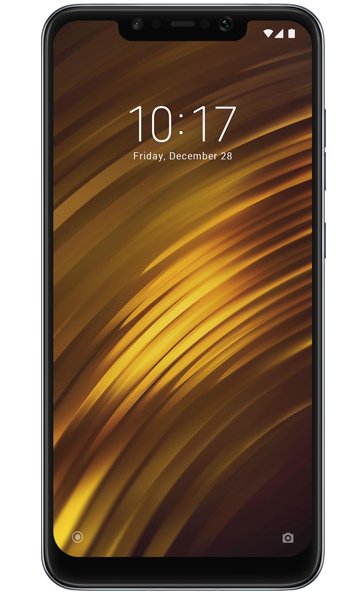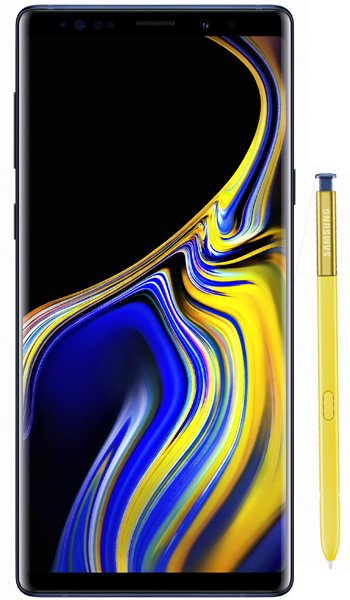Xiaomi Pocophone F1 vs Samsung Galaxy Note 9 Comparison and Differences
Smartphone 1

Xiaomi Pocophone F1
Smartphone 2

Samsung Galaxy Note 9
Smartphone 3
Xiaomi Pocophone F1 or Samsung Galaxy Note 9 Specs Comparison
or
 Common specs
Common specs
| Brand and model | Xiaomi Pocophone F1 | Samsung Galaxy Note 9 | |
| Rating | (+) | (+) | |
| Release date | 2018, August | 2018, August | |
| Dimensions (HxWxD) | 155.5 x 75.3 x 8.8 mm | 6.12 x 6.12 x 2.96 in | 161.9 x 76.4 x 8.8 mm | 6.37 x 6.37 x 3.01 in | |
| Weight | 182 g | 6.42 oz | 201 g | 7.09 oz | |
| Body Build | Front glass, plastic body | Front/back glass (Gorilla Glass 5), aluminum frame | |
| Case | buy from Amazon | buy from Amazon | |
| Colors | Graphite Black, Steel Blue, Rosso Red, Armored Edition with Kevlar | Metallic Copper, Lavender Purple, Ocean Blue, Midnight Black, Pure White, Alpine White | |
| Battery | 4000 mAh, Non-removable Li-Po | 4000 mAh, Non-removable Li-Ion | |
| Approximate price | 290 EUR | 750 EUR | |
| Check price | from Amazon | from Amazon |
 Screen
Screen
| Technology | IPS LCD | Super AMOLED | |
| Touchscreen | capacitive touchscreen | capacitive touchscreen | |
| Display colors | 16M | 16M | |
| Screen size | 6.18" in | 6.4" in | |
| Screen area | 96.2 cm2 | 103.2 cm2 | |
| Screen format | 18.7:9 (height:width) | 18.5:9 (height:width) | |
| Screen to body ratio | 82.2% | 83.4% | |
| Screen resolution | 1080 x 2246 px | 1440 x 2960 px | |
| Screen PPI /points per inch/ | 403 PPI | 516 PPI | |
| Screen protection | Corning Gorilla Glass (unspecified version) | Corning Gorilla Glass 5 | |
| Other specs | - HDR10 -Always-on display |
||
| Screen protector | buy from Amazon | buy from Amazon |
 Camera and Video
Camera and Video
| Rear camera, main | 12 MP, Dual | 12 MP, Dual | |
| Camera specs | -12 MP, f/1.9, 1/2.55'', 1.4µm, dual pixel PDAF -5 MP, f/2.0, 1.12µm, depth sensor |
-12 MP, f/1.5-2.4, 26mm (wide), 1/2.55'', 1.4µm, dual pixel PDAF, OIS -12 MP, f/2.4, 52mm (telephoto), 1/3.4'', 1.0µm, AF, OIS, 2x optical zoom |
|
| Functions | Dual-LED flash, HDR, panorama | LED flash, auto-HDR, panorama | |
| Video | 2160p@30fps, 1080p@30fps (gyro-EIS), 1080p@240fps, 720p@960fps | 2160p@60fps, 1080p@240fps, 720p@960fps, HDR, dual-video rec. | |
| DxOMark Main Score | 91 | 103 | |
| DxOMark Photo | 92 | 107 | |
| DxOMark Video | 90 | 94 | |
| Front camera, selfie | 20 MP, Single | 8 MP, Single | |
| Specifications | 20 MP, f/2.0, 0.9µm | 8 MP, f/1.7, 25mm (wide), 1/3.6'', 1.22µm, AF | |
| Functions | HDR | Dual video call, Auto-HDR | |
| Video | 1080p@30fps | 1440p@30fps | |
| DxOMark Selfie Score | 92 | ||
| DxOMark Photo | 96 | ||
| DxOMark Video | 86 |
 Performance
Performance
| Operating system - OS | Android 8.1 (Oreo), upgradable to Android 9.0 (Pie); MIUI 10.2 POCO | Android 8.1 (Oreo), upgradable to Android 9.0 (Pie); One UI | |
| Chipset | - Qualcomm SDM845 Snapdragon 845 (10 nm) | - Exynos 9810 Octa (10 nm) - Qualcomm SDM845 Snapdragon 845 (10 nm) - USA/LATAM, China |
|
| CPU | - Octa-core (4x2.8 GHz Kryo 385 Gold & 4x1.8 GHz Kryo 385 Silver) | - Octa-core (4x2.7 GHz Mongoose M3 & 4x1.8 GHz Cortex-A55) - EMEA -Octa-core (4x2.8 GHz Kryo 385 Gold & 4x1.7 GHz Kryo 385 Silver) - USA/LATAM, China |
|
| GPU | Adreno 630 | Mali-G72 MP18 - EMEA Adreno 630 - USA/LATAM, China |
|
| External memory | microSD, up to 256 GB (uses SIM 2 slot) | microSD, up to 512 GB (uses SIM 2 slot) - dual SIM model only | |
| Internal memory | 256 GB, 8 GB RAM 64/128 GB, 6 GB RAM | 512 GB, 8 GB RAM 128 GB, 6 GB RAM |
 Benchmark
Benchmark
| Antutu 8 Total | 355750 | 320265 | |
| Antutu 7 Total | |||
| GeekBench 6 Single Core | 491 | 521 | |
| GeekBench 6 Multi Core | 1628 | 1790 | |
| GeekBench 6 OpenCL | 2043 | 2025 | |
| GeekBench 6 Vulkan | 1916 | 1958 | |
| GeekBench 5 Single Core | 439 | 480 | |
| GeekBench 5 Multi-Core | 1754 | 2002 | |
| GeekBench 4 Single Core | 2194 | 2358 | |
| GeekBench 4 Multi-Core | 7695 | 8531 | |
| GeekBench 4 RenderScript | 12921 | 9353 | |
| GeekBench 4 Battery | 4646 | 5154 |
 Communication and Connectivity
Communication and Connectivity
| SIM card | Hybrid Dual SIM (Nano-SIM, dual stand-by) | Single SIM (Nano-SIM)Hybrid Dual SIM (Nano-SIM, dual stand-by) | |
| Network | GSM / HSPA / LTE | GSM / CDMA / HSPA / EVDO / LTE | |
| Bands | -2G - GSM 850 / 900 / 1800 / 1900 - SIM 1 & SIM 2 -3G - HSDPA 850 / 900 / 1900 / 2100 -4G - LTE band 1(2100), 3(1800), 5(850), 7(2600), 8(900), 20(800), 38(2600), 40(2300), 41(2500) |
-2G - GSM 850 / 900 / 1800 / 1900 - SIM 1 & SIM 2 (dual-SIM model only) CDMA 800 / 1900 - USA -3G - HSDPA 850 / 900 / 1700(AWS) / 1900 / 2100 CDMA2000 1xEV-DO - USA -4G - LTE band 1(2100), 2(1900), 3(1800), 4(1700/2100), 5(850), 7(2600), 8(900), 12(700), 13(700), 17(700), 18(800), 19(800), 20(800), 25(1900), 26(850), 28(700), 32(1500), 38(2600), 39(1900), 40(2300), 41(2500), 66(1700/2100), 71(600) - Global LTE band 1(2100), 2(1900), 3(1800), 4(1700/2100), 5(850), 7(2600), 8(900), 12(700), 13(700), 14(700), 17(700), 18(800), 19(800), 20(800), 25(1900), 26(850), 28(700), 29(700), 30(2300), 38(2600), 39(1900), 40(2300), 41(2500), 46, 66(1700/2100), 71(600) - USA |
|
| Speed | HSPA 42.2/5.76 Mbps, LTE-A (4CA) Cat16 1024/150 Mbps | HSPA 42.2/5.76 Mbps, LTE-A (5CA) Cat18 1200/200 Mbps | |
| GPRS | Yes | Yes | |
| Edge | Yes | Yes | |
| Wi-Fi | Wi-Fi 802.11 a/b/g/n/ac, dual-band, Wi-Fi Direct, DLNA, hotspot | Wi-Fi 802.11 a/b/g/n/ac, dual-band, Wi-Fi Direct, hotspot | |
| GPS | Yes, with A-GPS, GLONASS, BDS | Yes, with A-GPS, GLONASS, BDS, GALILEO | |
| NFC | Yes | ||
| USB | 2.0, Type-C 1.0 reversible connector, USB On-The-Go | 3.1, Type-C 1.0 reversible connector | |
| Bluetooth | 5.0, A2DP, LE, aptX HD | 5.0, A2DP, LE, aptX |
 Music and Audio
Music and Audio
| Radio | FM radio, recording | No | |
| Headphone jack | Yes | Yes | |
| Others | - Active noise cancellation with dedicated mic | - 32-bit/384kHz audio -Active noise cancellation with dedicated mic |
 Other features
Other features
| Sensors | - Infrared face recognition, fingerprint (rear-mounted), accelerometer, gyro, proximity, compass | - Iris scanner, fingerprint (rear-mounted), accelerometer, gyro, proximity, compass, barometer, heart rate, SpO2 | |
| Other extras |
- Fast battery charging 9V/2A 18W (Quick Charge 3.0) |
- Samsung DeX (desktop experience support) -ANT+ -Bixby natural language commands and dictation - Fast battery charging (Quick Charge 2.0) -Qi/PMA wireless charging (market dependent) - - Samsung Pay (Visa, MasterCard certified) -IP68 dust/water proof (up to 1.5m for 30 mins) -Stylus (Bluetooth integration) |
|
| Versions |
- Also known as Xiaomi Poco F1 in India |
- SM-N960F/DS (Global); SM-N960U (USA); SM-N9600/DS (LATAM, Brazil, China) |
Reviews and Opinions on Xiaomi Pocophone F1 and Samsung Galaxy Note 9
If you had to recommend one of these phones to a friend, which one would it be and why? Share your arguments using the Add Opinion button!

